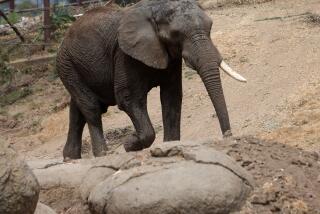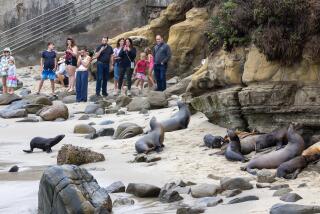Labors of Love at ‘The Hospital’
- Share via
It’s a gray day at “the hospital” and the peculiar groans of the sick and injured are billowing into the sky.
They’re as forlorn a bunch of patients as you can imagine.
The really young ones, most suffering from pneumonia, stare with large, mournful eyes. The older, much larger ones battle a more severe malady caused by a toxin in the fish they ate.
Theirs is a life-or-death struggle and you need only watch them tremble to realize it. You wish you could ease their pain.
But there is some brightness amid the gloom of an overcast day at the Marine Mammal Care Center at Ft. MacArthur, where eight northern elephant seal pups and nine California sea lions are being treated in hopes that they can be released back into the wild.
There are dedicated people at the center who can help--who can ease the pain. And to watch them work sets spirits soaring.
They are Jackie Jaakola, Jennifer Sullivan and Jeanine Mauch--and their many volunteers.
“The Three Js,” as they’re affectionately called, are the only paid employees at the small San Pedro facility, which this year is celebrating its 10th anniversary.
“I can’t imagine doing anything else,” said Jaakola, 35, the director, who has worked at the center for nine years. “This is a lifestyle. This isn’t a job. You have to love it. I’m very passionate about it, I’m proud of it. This is my family.”
Sullivan, 26, started as a volunteer and eventually filled Jaakola’s previous role as operations manager. Both have backgrounds in marine biology and animal care. They are paid about what an entry-level teacher earns through a trust fund set up by the owners of nearby Marineland after that facility closed in 1987.
Mauch, 54, the only marine science instructor the center has had, is paid by the Los Angeles Unified School District, on whose property the facility sits. As for the dozens of volunteers, most of them women, they are the heart and soul of the center.
But the family Jaakola refers to, to some extent, also includes the marine mammals, mostly seals and sea lions, that come in with various sicknesses and injuries. They have been delivered with broken jaws, lacerations caused by discarded fishing line, shark bites and even bullet holes.
Jaakola points to a picture on a desk showing her beside a tiny sea lion, wearing a leash, that came in with a serious bone infection in its flippers. The pup’s physical therapy involved regular walks through the halls and swimming lessons by a staff that has learned to improvise.
“We put her in a little tiny seat belt and would hang her in the water like a seal on a string; otherwise she would have drowned,” Jaakola recalls with a smile. “That was a happy release. She swam off fatter than could be.”
Happy releases, though they don’t always happen, are what the facility is all about.
Last year, an adult female sea lion came in suffering from domoic acid poisoning, the same ailment that affects the nine sea lions now in-house. She weighed only 189 pounds--she could have weighed twice as much--and for nine days experienced violent seizures. She didn’t respond to medicine and drifted into semiconsciousness.
But then Jaakola and Sullivan decided to violate a “rule of thumb” that says you wait until an animal is awake before you feed it, lest the animal suffocate if it vomits.
They worked a tube down her throat to deliver a blend of food and a new medicine. The next day the sea lion was alert and sitting up. A week later she was eating on her own. A month after her arrival, she was set free on a beach and went porpoising off into the ocean.
“Sometimes you have to take risks,” Jaakola said.
Different circumstances surrounded a northern fur seal pup that came to be called “Her Highness.” She was picked up by animal control workers in October while trying to cross Pacific Coast Highway in Santa Monica.
The malnourished little fur ball, which somehow had swum more than 60 miles from its birthplace on remote San Miguel Island, became the star patient. She lounged by her pool and ate smelt, sardines and herring for more than a month.
Finally, she was given a boat ride back to San Miguel Island. But she apparently loved L.A. Only days after her release, she returned to the same beach and ended up back at the care center.
She has since been delivered to a similar facility in Sausalito, where she is suffering from a loss of “guard hairs” necessary to keep her warm in cold water. She will probably end up in a zoo.
On this day, keeping warm is no problem for the elephant seal pups, which have just been fed a breakfast of either whole fish or “gruel,” a blended mix of milk powder, electrolytes and sardines.
Sullivan and her volunteers arrived at sunup for meal preparation, which involves skinning the fish, lopping off heads and tails and, of course, the blending.
Spring is a busy time at the center. Elephant seals are born in December or January. Some are abandoned by their mothers. Others simply become separated.
Sea lions are born in late May or early June. The sick and injured pups will be arriving sporadically in the coming weeks.
On this day fourth-graders visiting from Windsor Hills Elementary School in Los Angeles get a lesson in the ways of nature they won’t soon forget.
Domoic acid poisoning, Mauch tells them, is a natural event caused by toxic algae blooms that occur to some extent seasonally off California. The algae are ingested by fish, which in turn are snapped up by dolphins, seals and sea lions. The fish appear unharmed but the mammals grow disoriented and the poisoning often proves fatal.
Sullivan, Jaakola and three volunteers are in one pen, wearing thick gloves and coveralls, and using sheets of plywood to herd the sea lions, one after another, into a “squeeze cage,” where they’re immobilized and fed through tubes.
In another cage, one of the fresh arrivals twitches from seizures. The kids, immediately beyond the pen’s chain-link fence, step back and gasp.
They’re witnessing one of the first waves of sea lions that will eventually fill the concrete floors of the center’s pens, during one of the most severe domoic acid outbreaks in recent history.
Jaakola sighs, saying this season is already reminiscent of the violent El Nino winter of 1997-98, when nearly constant storm surf literally pounded thousands of seals and sea lions into submission. This center, one of six statewide, housed up to 82 animals at a time and treated 440 overall.
“This is busy. That was war,” she recalls.
*
(BEGIN OF INFOBOX)
Where to Call
To report a sick or injured sea mammal or sea bird washed ashore on the beaches of Southern California, contact the animal control agency in that city or:
* The Whale Rescue Team, at (800) 39-WHALE.
* The Marine Mammal Care Center, at (310) 548-5677. The Web site for the center: www.mar3ine.org.






